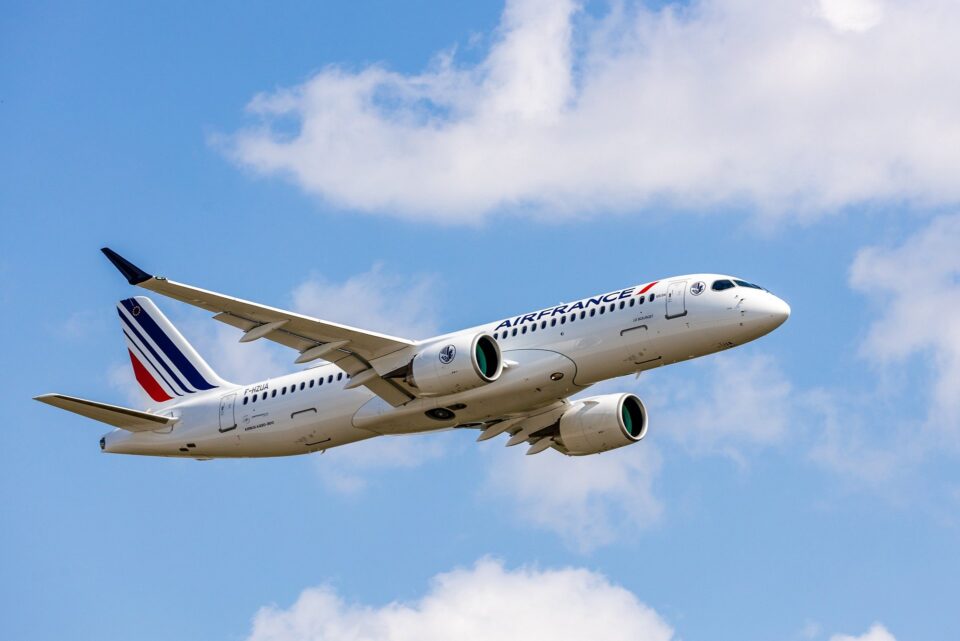Aviation
Airbus delivers first of 60 A220s to Air France

Mirabel, Quebec, Canada, 29 September, 2021 – Air France has received its first A220-300 from an order for 60 aircraft of the type, the largest A220 order from a European carrier. The aircraft was delivered from Airbus’ final assembly line in Mirabel, Quebec, Canada and officially unveiled to the public during a ceremony held at Paris Charles-De-Gaulle Airport.
The A220 is the most efficient and flexible aircraft in the 100 to 150 seat market segment today. The renewal of the Air France single-aisle fleet with this latest generation aircraft will increase efficiency along with customer comfort and support Air France to meet its environmental goals and sustainability objectives.
The first Air France A220-300 will be operated on its medium-haul network from the 2021 winter season. Currently, Air France operates a fleet of 136 Airbus aircraft. Air France is also renewing its long-haul fleet, and has already taken delivery of 11 A350s out of an order of 38.
The Air France A220-300 cabin is configured in a single-class layout to comfortably welcome 148 passengers. Offering superior single-aisle comfort, with the widest leather seats, largest windows and up to 20% more overhead stowage space per passenger, the Air France A220 also features full WiFi connectivity throughout the cabin and two USB sockets at each passenger seat.
The A220 is the only aircraft purpose-built for the 100-150 seat market and brings together state-of-the-art aerodynamics, advanced materials and Pratt & Whitney’s latest-generation geared turbofan engines. With a range of up to 3,450 nm (6,390 km), the A220 gives airlines added operational flexibility. The A220 delivers up to 25% lower fuel burn and CO2 emissions per seat compared to previous generation aircraft, and 50% lower NOx emissions than industry standards. In addition, the aircraft noise footprint is reduced by 50% compared to previous generation aircraft – making the A220 a good neighbour around airports.
India formalises acquisition of 56 Airbus C295 aircraft
As of the end of August, over 170 A220s have been delivered to 11 operators worldwide.
Further information on the A220 Family, please click here
#A220 #Airbus #AirFrance

Aviation
Boeing, Antonov to Collaborate on Defense Projects

– MOU represents Boeing’s commitment to work with Ukrainian industry
– Includes exploring opportunities for collaborating on in-country support of Unmanned Aerial Systems
A Memorandum of Understanding was signed today by Boeing and Antonov Company to investigate potential collaboration on defense-related projects.
“We’re happy to keep collaborating with the Antonov Company to help Ukraine’s economic development and expansion,” stated Ted Colbert, CEO and president of Boeing Defence, Space, & Security.
Airbus and the Antonov An-225: The Best Partnership:Click here
“This agreement demonstrates our ongoing efforts to find more opportunities to work with Ukrainian industry, which was underscored by our signing of the Ukrainian Defence Industry Compact earlier this year.”
The areas of potential collaboration identified in the agreement consist of training, logistical support and overhaul services for tactical Unmanned Aerial Systems utilized by the Ukrainian Armed Forces, which includes the ScanEagle. In addition, the companies will also explore opportunities for Antonov to provide engineering support to Boeing.
The six largest cargo aircraft ever built in the aviation industry:Click here
“A strong, innovative, and efficient defense industry is key to sustainable economic development and national security, and we are extremely excited to collaborate with Boeing,” said Ievhen Gavrylov, CEO of Antonov Company.
This agreement brings a whole new level of opportunity to implement the latest and most effective solutions – in addition to the possibility of future projects with Boeing in the aerospace and defense industry.”
-

 Travel1 week ago
Travel1 week agoAir India to Expand US Operations with Three New Routes After a Decade
-

 Travel2 weeks ago
Travel2 weeks agoWhy We Should Avoid These Stamps in a Passport
-

 Airlines1 month ago
Airlines1 month agoInvestigations Reveal Fake Chinese Titanium in Boeing and Airbus Jets
-

 Tech4 weeks ago
Tech4 weeks agoChina’s CATL Plans 1,800-Mile Electric Plane Launch by 2027
-

 Airport3 days ago
Airport3 days agoTop 10 Largest Airports in the World by Size
-

 Aerospace4 weeks ago
Aerospace4 weeks agoChina’s Fighter Jets Turn Wings into Autonomous Drones
-

 Airlines4 days ago
Airlines4 days agoAir India Rolls Out A350s for Delhi-New York JFK and Newark Routes
-

 Defence3 weeks ago
Defence3 weeks agoBoeing Enhances Chinook with New Engines and Block II Upgrades at $96 Million







